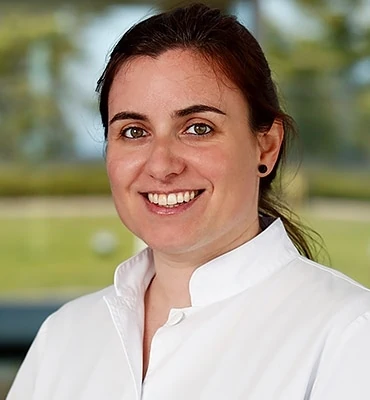What is Stargardt disease?
Stargardt disease is a hereditary disorder that affects the central area of the retina: the macula. It is characterised by causing progressive degeneration of the cells of the retina, such as the photoreceptors (cones and rods), which are responsible for converting light into nerve impulses that the brain transforms into images.
Despite being the leading cause of hereditary macular dystrophy in childhood, it is considered a rare or minority disease, since it is estimated that it affects only 1 in 10,000 people.
What causes it?
Stargardt disease is caused by mutations in the ABCA4 gene, which is responsible for other retinal dystrophies. It is usually transmitted through a pattern of autosomal recessive inheritance, which means that the parents of affected people do not suffer from the disease but are carriers of the gene that causes it.
How can it be prevented?
Because it is a hereditary disease, it cannot be prevented. Once diagnosed, however, patients are advised to avoid vitamin A-based supplements since studies on animals have shown that vitamin A accelerates the progression of the disease. Sufferers are also recommended to protect themselves from intense light, especially sunlight, by using sunglasses with dark filters because light exposure accelerates the evolution of the disease.
Symptoms
Stargardt disease manifests itself between childhood and the age of 30. The first symptom that sufferers usually experience is slow and progressive loss of central vision (visual acuity). It is, therefore, a disease that especially affects the ability to see fine detail and everyday activities such as reading and recognising the faces of relatives.
As the disease progresses, vision loss becomes more severe and, in later stages, patients usually retain a certain degree of peripheral vision, as well as, approximately, 10% of their visual acuity. There is also a relatively uncommon variant of Stargardt disease, also caused by the mutation of the ABCA4 gene, known as fundus flavimaculatus (FF), whose evolution is slower but affects peripheral vision more severely.
Associated treatments
There is currently a lack of treatment for Stargardt disease. Because of this, the IMO Foundation is carrying out research into the ABCA4 gene through the crowdfunded project Investigating a gene in collaboration with the La Caixa Banking Foundation and ONCE. The goal is to study the mutations that cause the disease and other retinal dystrophies. To achieve this, the plan is to test new gene and cell therapies using cells previously donated by patients suffering from these diseases in order to return vision or stop associated vision loss over the next decade.
Gene therapies could be used on patients suffering from the most incipient stages of the disease. They will consist of introducing into patients healthy copies of the mutated gene, which have been artificially created in a laboratory, to perform the function of the gene.
The most advanced cases will not be able to benefit from gene therapies because the disease causes irreparable damage to the cells of the retina as it evolves. It is envisaged that these patients will be able to undergo stem cell transplantation (cell therapy) to replace the damaged tissue.
Specialists who treat this pathology
FAQs
A lot of research work in this field still needs to be carried out for stem cells to be applied to patients suffering from eye diseases, especially relating to the retina.
Angiography is a technique used to delineate retinal or choroidal cases. Different contrasts are used, usually sodium fluorescein or indocyanine green. The scan is also useful for the diagnosis of other retinal diseases, such as pigment epithelium. In general, angiography is used to study many retinal diseases and their diagnosis.
It is a diagnostic technique to determine pathological and abnormal structures in the blood vessels and the different layers of the retina. It can be used in cases of macular degeneration, diabetic retinopathy, vasculopathy and many other macular disorders.
IMO Institute of Ocular Microsurgery
Josep María Lladó, 3
08035 Barcelona
Phone: (+34) 934 000 700
E-mail: international@imo.es
See map on Google Maps
By car
GPS navigator coordinates:
41º 24’ 38” N – 02º 07’ 29” E
Exit 7 of the Ronda de Dalt (mountain side). The clinic has a car park with more than 200 parking spaces.
By bus
Autobus H2: Rotonda de Bellesguard, parada 1540
Autobus 196: Josep Maria Lladó-Bellesguard, parada 3191
Autobuses H2, 123, 196: Ronda de Dalt – Bellesguard, parada 0071
How to arrive at IMO from:
IMO Madrid
C/ Valle de Pinares Llanos, 3
28035 Madrid
Phone: (+34) 910 783 783
See map in Google Maps
Public transport
Metro Lacoma (líne 7)
Autobuses:
- Lines 49 & 64, stop “Senda del Infante”
- Line N21, stop “Metro Lacoma”
Timetables
Patient care:
Monday to Friday, 8 a.m. to 8 p.m.
IMO Andorra
Av. de les Nacions Unides, 17
AD700 Escaldes-Engordany, Andorra
Phone: (+376) 688 55 44
See map in Google Maps
IMO Manresa
C/ Carrasco i Formiguera, 33 (Baixos)
08242 – Manresa
Tel: (+34) 938 749 160
See map in Google Maps
Public transport
FGC. Line R5 & R50 direction Manresa. Station/Stop: Baixador de Manresa
Timetables
Monday to Friday, 08:30 A.M – 13:30 PM / 15:00 PM – 20:00 PM















